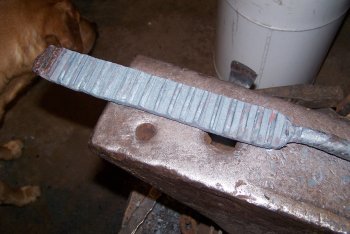OK....first, I need to know if you are familar with how to achieve a ladder pattern, with ladder pattern dies, that the pattern being "pressed" in. This methodology requires that you grind away AT LEAST 2/3 of your finished/pressed billet. Are you aware of that?
Everybody has their favorite layer count....for me it is AT LEAST 300 layers..... anything less looks "cheap" IMO, as if the person making it was trying to save money on steel.
How thick you leave the billet prior to pressing in the ladder pattern is dictated by how thick you desire the finished blade to be. A rough foumula is that you want your billet to be 2/3 THICKER THAN THE DESIRED END THICKNESS. IF you want a finished thickness of approx 1/4", then you want AT LEAST 3/4" thick prior to pressing in the ladder (I would go slightly more). The whole idea behind pressing in a patter is that the patter GOES ALL THE WAY THROUGH THE BILLET, AND CANNOT BE GROUND OUT. The down side to the process is that you have no war around it.... YOU MUST GRIND AWAY/WASTE 2/3 OF YOUR BILLET.
No matter what I tell you, there is going to be a HUGE learning curve, simple because you're going to have to discover how, and how much you need to press to make the pattern go all the way through the billet, AND how much you mst grind away (gona be "more or less") of what I mentioned, depending on how everything in the process went). l You're also going to have to figure out an economical way to grind away 2/3 of each billet you press pattern into..... it's a LOT of time, effort, and is very spendy in the way of abrasives.
Personally, I pressed patterns for about a year, and because of the tremendous waste, not only of billets/steel, but in grinding media, time, and effort..... I quit, and gave away all my pattern pressing dies. I just don't do it anymore.

